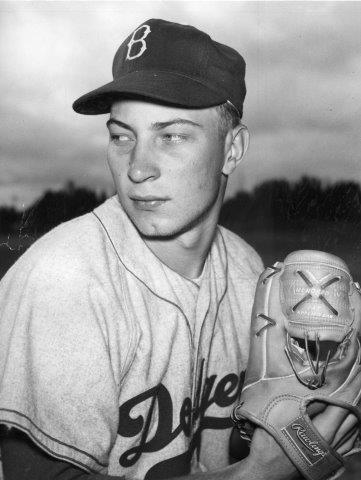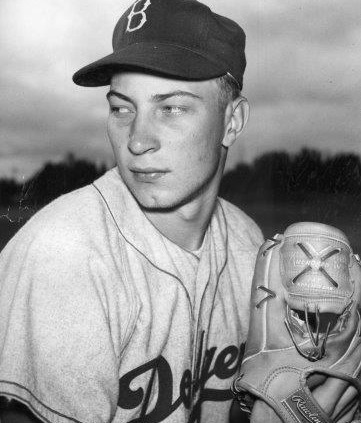September 30, 1955: Podres, Dodgers narrow Yankees’ lead in Game 3

After “two days of aimless wandering,”1 the Dodgers returned home for World Series Game Three in front of the largest crowd of the season at Ebbets Field, 34,209 boisterous fans. There was an enthusiasm among Dodgers fans that belied their 0-2 Series deficit and rather long odds of being able to finally win a World Series.2 As the starting pitchers began warming up, Gladys Gooding, Ebbets Field organist since 1942, played her rendition of “Happy Birthday to You.” Dodgers fans added their voices, realizing that the Dodgers starting left-hander Johnny Podres (9-10, 3.95 ERA) was celebrating his 23rd birthday.3
Casey Stengel selected hard-throwing but erratic Bob Turley (17-13, 3.06 ERA) to start Game Three for the Yankees. Stengel was hoping that the Turley with six shutouts and 210 strikeouts for the season would take the mound. Turley led American League pitchers in 1955 with 177 walks.
Podres first pitched against the Yankees as a 20-year-old rookie in the 1953 Mayor’s Trophy Game, an annual in-season exhibition game in New York.4 He pitched seven innings in the Dodgers’ 9-0 victory, allowing only four Yankees to reach base.5 Later that season, Podres made his World Series debut against the Yankees, in Game Five at Ebbets Field. It was an inauspicious outing. In the third inning with the score tied at 1-1, two outs, and Phil Rizzuto on third, a fielding error by first baseman Gil Hodges allowed Rizzuto to score. Perhaps the rookie was unnerved. He hit Hank Bauer and walked Yogi Berra, and his afternoon was over. The Yankees scored five runs in the inning, including a grand slam by Mickey Mantle off Russ Meyer. They won Game Five that afternoon and the World Series on the next day.
Podres’ 1955 regular season started well but finished in mediocrity. By mid-June his record stood at 7-3; he had pitched consecutive shutouts against the Cincinnati Redlegs and completed his fifth game of the season. He was bothered with a sore arm and shoulder trouble at various times during the season and didn’t throw another complete game after those shutouts. Remarkably, Podres’ availability for the World Series was even in doubt in September after a freak accident. The batting cage was being moved off the field. Podres remembered: “They started wheeling that thing and, jeez, they hit me right in the side with it. Banged up my ribs pretty good. For two or three weeks I could hardly breathe.”6
The Game Three box score reveals that the Dodgers’ offensive production was scattered throughout the lineup. Everyone but Gil Hodges had at least one hit; but the bat of Roy Campanella stood out. Campanella was about to become the National League MVP for the third time, but in the first two games of this Series, he was 0-for-8. His two-out home run off Turley in the bottom of the first inning, scoring Pee Wee Reese ahead of him, gave “Dem Bums”7 a 2-0 lead. Just as they had responded in each of the first two games, the Yankees did it again. Mickey Mantle, starting in his first game since September 16 because of a torn right thigh muscle, clobbered a solo home run to the deepest part of the center-field bleachers to lead off the second inning.8 Bill Skowron followed with a double down the left-field line. With two outs, Phil Rizzuto singled to left. Campanella moved up the line to get the throw from left fielder Sandy Amoros. Skowron ran straight into Campy, the ball came loose, and the score was tied, 2-2.
The Dodgers had a wild Bob Turley on the ropes in the second and he wouldn’t survive. With one out, Jackie Robinson singled and Amoros was hit by a pitch. Turley couldn’t field a bunt by Podres and the bases were loaded. When Turley forced in a run by walking Jim Gilliam, Yankees manager Casey Stengel had seen enough. Turley was replaced on the mound by Tom Morgan, who promptly walked Reese for another run and a 4-2 Dodgers lead.
The Dodgers were scoring runs in pairs and continued to do so in the fourth inning against Morgan. Gilliam opened with a single to left field. With one out, Duke Snider walked, already the fifth walk given up by a Yankees pitcher. Campanella singled to left for his third RBI of the afternoon, scoring Gilliam and advancing Snider to third. Carl Furillo‘s foul pop fly down the left-field line scored Snider for a 6-2 Dodgers lead.
Meanwhile as the Dodgers kept adding to their lead, Podres was getting stronger. His third and fourth innings were “three up, three down”9 with three strikeouts. A walk to Phil Rizzuto in the fifth inning was of no consequence. Singles in the sixth by Gil McDougald and Yogi Berra mattered little when Mantle, having difficulty running, grounded into a double play. The Yankees managed to add a run in the seventh inning, when Podres walked Phil Rizzuto with two outs. Pinch-hitter Andy Carey tripled to left, scoring Rizzuto, before Podres struck out Bob Cerv for the third time.
When the Dodgers came to bat after the seventh-inning stretch, it was time to put some icing on Podres’ birthday cake. Robinson doubled to left off Tom Sturdivant. When left fielder Elston Howard threw into second base, Robinson scampered to third and scored on Sandy Amoros’ single to right. Podres tried to bunt Amoros over but wound up forcing him at second. After Gilliam walked, Pee Wee Reese delivered a single to center for an 8-3 Dodgers lead.
In the ninth inning, Podres yielded an opening single to Skowron, but three infield pop flies later he had the complete game and the victory. Never before had the Dodgers won a World Series game by more than four runs.10 After the game, Podres credited former Dodgers manager Chuck Dressen with teaching him how to throw a changeup. “It was my changeup that did it. I kept them off balance most of the day with my ‘out’ ball.”11
The Dodgers could certainly celebrate key performances throughout their lineup. For example, Jackie Robinson’s outstanding play covered the gamut: a single, a double, two runs scored, opportunistic baserunning in the seventh inning and seven assists playing the hot corner. Sandy Amoros’ first World Series start was perfection – a single, two walks and a hit-by-pitch – and Junior Gilliam had two walks and a single. After his dramatic steal of home in the Dodgers’ loss in Game One, Robinson said, “Whether it was because of my stealing home or not, the team had a new fire.”12 Was their Game Three victory an indication of that fire?
Appropriately, the afternoon’s victory celebration had to conclude with another happy-birthday wish for Podres by Gooding and the remaining fans.13 Along with a festive mood, there must have been a sense of relief in Brooklyn that, indeed, this World Series was not going to be a one-sided affair.
AUTHOR’S NOTE
On the field in just a few days’ time, Johnny Podres went from one of the Dodgers heroes in Game Three to the World Series Most Valuable Player after Game Seven and the Brooklyn Dodgers were champions for the first time.14 How did Podres do it? Simple. He followed Campanella’s advice given as they sat quietly in the clubhouse discussing Yankee hitters minutes before the pregame warmup for Game Seven. “Just get that changeup over like the other day,” Campy said. ‘Get it over, you got nothing to worry about.”15 He did that for the first three or four innings, “but over the last five I stayed pretty much with the fastball … with the ball flashing from sunlight into shadow.”16 Podres shook off his catcher only once in the entire Game Seven and it was on the last pitch. “I wanted a fastball,” Campy said. “He wanted a changeup. That boy had the last word. He sure did.”17 They both got it right and the wait ‘til next year was over.
Baseball was played “between the white lines”18 at Ebbets Field in the early to mid-1950s against the backdrop of owner Walter O’Malley‘s relentless drive to find a new home for his Dodgers. In fact on this very day (September 30, 1955), architect Buckminster Fuller, commissioned by O’Malley, revealed design plans for a circular domed stadium intended to replace Ebbets Field.19 In his World Series diary, sportswriter Dan Daniel added his own prognosis, “I dare say Bob Moses is not likely, now, to oppose the wishes of the people of Brooklyn as regards that new ball park Walter O’Malley wants to build at Flatbush and Atlantic avenues.”20 Soon enough, Dodgers fans of all ages would learn otherwise!
SOURCES
The author accessed Baseball-Reference.com for box scores/play-by-play information (baseball-reference.com/boxes/BRO/BRO195509300.shtml) and other data, as well as Retrosheet.org (retrosheet.org/boxesetc/1955/B09300BRO1955.htm).
Photo credit: Johnny Podres, National Baseball Hall of Fame Library.
NOTES
1 John Drebinger, “Dodgers Win 8-3; Cut Series Lead of Yankees to 2-1,” New York Times, October 1, 1955: 1.
2 Douglas Jordan, “World Series Situation Winning Probabilities: An Update,” SABR Baseball Research Journal, Vol. 48, No. 1 (Spring 2019): 70. Data analyzed as part of SABR research concludes that a team that loses the first two games of a World Series has a 20 percent chance of winning the Series.
3 “Dodgers, Back in Flatbush, Swing Away Behind Podres,” The Sporting News, October 12, 1955: 22.
4 The game was played at Yankee Stadium on June 29, 1953, in front of 56,136 fans, the largest New York baseball crowd of the season to that point. Wayne Belardi was the MVP, driving in six runs with two home runs and a double.
5 David Krell, “Johnny Podres,” SABR Baseball Biography Project, sabr.org/bioproj/person/14288820.
6 Donald Honig, The October Heroes (New York: Simon & Schuster, 1979), 210.
7 Paul Dickson, The Dickson Baseball Dictionary, 3rd Edition (New York: W.W. Norton & Company, 2009), 250. “Traditional affectionate nickname for the Brooklyn Dodgers, established and characterized by a bewhiskered, cigar-chomping cartoon tramp drawn by Willard Mullin.”
8 Drebinger.
9 Paul Dickson, 869. “Said of an inning in which the three batters are retired in order.”
10 Drebinger.
11 The Sporting News, October 12, 1955: 23.
12 Jackie Robinson, I Never Had It Made (New York: Putnam, 1972), 120.
13 Bob McGee, The Greatest Ballpark Ever (New Brunswick: Rivergate Books, 2005), 246.
14 Steven C. Weiner, “October 4, 1955: Brooklyn Dodgers win first World Series as ‘Next Year’ finally arrives,” SABR Games Project.
15 Milton Gross, “Podres Greatest Day,” Baseball Digest, November-December 1955: 41.
16 Honig, 212.
17 Gross, 42.
18 Paul Dickson, 102. “On the field of play, the location of the action of the game itself, as opposed to off-the-field activity.”
19 McGee, The Greatest Ballpark Ever.
20 Dan Daniel, “Over the Fence: A World Series Reporter Gossips (Tuesday, October 4),” The Sporting News, October 12, 1955: 10.
Additional Stats
Brooklyn Dodgers 8
New York Yankees 3
Game 3, WS
Ebbets Field
Brooklyn, NY
Box Score + PBP:
Corrections? Additions?
If you can help us improve this game story, contact us.


